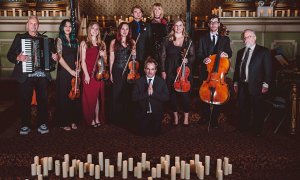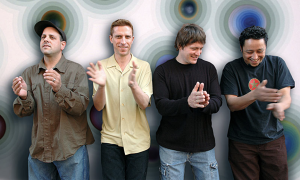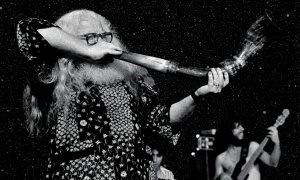Home » Jazz Articles » From the Inside Out » Classical Echoes: Feldman, Tjader and Aguabella
Classical Echoes: Feldman, Tjader and Aguabella
'Love for Sale' starts out as the Cole Porter classic but ends up a smoking Afro-Cuban jam.
 In December 1958, Victor Feldman – pianist, percussionist, and vibes player – began work on a project as a leader for Contemporary records. He continued work on this project for nearly a year, ultimately recording two different quintets plus a ten-piece unit with contributions from bassists Al McKibbon and Scott LaFaro, soloists Walter Benton (tenor sax), Conte Candoli (trumpet), and Frank Rosolino (trombone), pre- Peanuts pianist Vince Guaraldi, and the best percussion ensemble in the history of jazz: The triple threat of Willie Bobo, Armando Peraza and Mongo Santamaria – George Shearing’s percussion section.
In December 1958, Victor Feldman – pianist, percussionist, and vibes player – began work on a project as a leader for Contemporary records. He continued work on this project for nearly a year, ultimately recording two different quintets plus a ten-piece unit with contributions from bassists Al McKibbon and Scott LaFaro, soloists Walter Benton (tenor sax), Conte Candoli (trumpet), and Frank Rosolino (trombone), pre- Peanuts pianist Vince Guaraldi, and the best percussion ensemble in the history of jazz: The triple threat of Willie Bobo, Armando Peraza and Mongo Santamaria – George Shearing’s percussion section.“I tried to blend straightforward arrangements in the Latin and Afro-Cuban vein with the improvisations of the jazz soloists,” Feldman said of his first Latin jazz set, “and it seems to me that Conte Candoli, Walter Benton and Frank Rosolino play with the swinging pulsation that they normally would with regular piano, bass, and drums rhythm.” The resultant Latinsville! (Contemporary) album is now reissued by Fantasy, including five previously unreleased tracks.
As a soloist, Feldman whisks through his ending to “Flying Down to Rio,” then his mid-song feature in “Cuban Pete” swings very deeply in Bags’ (Milt Jackson’s) bag. He also dances brilliantly against the amazingly timed percussion melody of “Cuban Love Song.”
But the musicianship of the other musicians – the percussionists and horn / brass soloists in particular, but also the bass and piano players – play as large a part in the excellence of this music as Feldman does. For example, as you’d expect, the three horn players, particularly Candoli, shine in Dizzy Gillespie’s “Woody’N You,” sound-surfing along the rhythm churned by the percussionists. “In A Little Spanish Town” rocks to its foundation from the percussionists, too.
Like this Gillespie tune, a previously unreleased alternate take of “Poinciana” is more jazz than Latin, very different from the version released on the original Latinsville! set. It’s straight-up quintet jazz quintet sans percussionists, driven both in support and as a soloist by bassist LaFaro, whose rhythm somehow sounds so essential and who solos as smooth and rich as the deepest, darkest chocolate.
Feldman would later work with Cannonball Adderley and Miles Davis, who recorded Feldman’s composition as the title track for his Seven Steps to Heaven album in 1963.
 The Shearing bands with Willie, Armando, and Mongo also featured Cal Tjader. After his time with Shearing, Tjader employed his drums, timbales, percussion and vibes as a longstanding pillar of the San Francisco jazz scene. Bobo and Santamaria would later realign with Tjader in some of these bands. So did Guaraldi, whose dancing, crystalline piano style served the Latin idiom well, especially in the context of Tjader’s chiming vibes and shimmering rhythms.
The Shearing bands with Willie, Armando, and Mongo also featured Cal Tjader. After his time with Shearing, Tjader employed his drums, timbales, percussion and vibes as a longstanding pillar of the San Francisco jazz scene. Bobo and Santamaria would later realign with Tjader in some of these bands. So did Guaraldi, whose dancing, crystalline piano style served the Latin idiom well, especially in the context of Tjader’s chiming vibes and shimmering rhythms.
About two decades after Feldman entered the studio for Contemporary, Tjader recorded this performance at San Francisco’s Great American Music Hall. Though Cuban Fantasy (Fantasy) moves forward in jazz two decades from Feldman’s time of Broadway, ballads, blues and bop to electric jazz and fusion, like Latinsville! it remains consistent with the instrumentation and devices of its time. Trumpet, trombone and saxophone are gone as solo instruments, replaced by Bob Redfield’s electric guitar and keyboards from Clare Fischer. Bassist Rob Fisher, drummer Pete Riso, and conguero / percussionist Poncho Sanchez complete this ensemble.
Cuban Fantasy bursts open with the electric adventurous spirit of jazz fusion: Instead of a dozen songs generally between three to five minutes in length, the time standard during the era of Feldman’s set, it presents eight tracks between six and thirteen minutes long (“in concert” helps this feeling along, too). “Guarabe” exudes this spirit, cycling upon an electric piano riff, underscored by the hop, skip n’ jumping drum pattern, that serves as launching pad for spacey explorations by the guitarist and pianist. It is so loose that it doesn’t really seem to have an ending, the band sort of just stops playing it. “Manuel Deeghit” also jams on a riff hung upon its rhythmic backbone supple yet strong as a python. Tjader digs deeps into his Milt “Bags” Jackson bag, fluid and bluesy, here.
Tjader’s way with melody is simply a gift, a gift on display as he dances through the opening “Cuban Fantasy.” It is quickly apparent why this descarga (jam session) was chosen as the first and title track to this set, as Tjader pirouettes through its melody and Sanchez pounds out an amazing flurry of warm notes played almost too fast to be distinguished individually – a wall of conga sound. Sanchez also surpasses description in “Tamanco no Samba (Samba Blim),” where keyboardist Fischer sits out most of the solos in the middle section so they feel tuned to the percussion and drum beats, quite free and hot.
“Descarga Cachao” and the crowd-pleasing finale “Guachi Guara (Soul Sauce)” – a Dizzy Gillespie composition but Tjader’s signature piece – deliver the spiritually charged and spicy sustenance their titles promise. Tjader scales magnificent summits of vibes and timbales in each, especially inspiring the other soloists in “Cacao,” and Sanchez proves worthy of the great percussionists’ mantle of Bobo and Santamaria passed to him through Tjader.
 Now fast forward about a quarter of a century to Francisco Aguabella’s present day release, Ochimini (Cubop). Aguabella has worn the mantle of Afro-Cuban percussion royalty for about twice that – half a century – since he arrived in New York City from Matanzas, Cuba, in the late 1950s. Among the first generation of Afro-Cuban percussionists who emigrated to the States, his legend stands from his work inside and outside Latin jazz spheres: He has worked with Tjader and Machito and Eddie Palmieri, and with Carlos Santana; he’s worked with Gillespie and Nancy Wilson, with Weather Report, and Frank Sinatra, too.
Now fast forward about a quarter of a century to Francisco Aguabella’s present day release, Ochimini (Cubop). Aguabella has worn the mantle of Afro-Cuban percussion royalty for about twice that – half a century – since he arrived in New York City from Matanzas, Cuba, in the late 1950s. Among the first generation of Afro-Cuban percussionists who emigrated to the States, his legend stands from his work inside and outside Latin jazz spheres: He has worked with Tjader and Machito and Eddie Palmieri, and with Carlos Santana; he’s worked with Gillespie and Nancy Wilson, with Weather Report, and Frank Sinatra, too.
Aguabella composed the leadoff, title track, and peppers it with his congas, but blazing trumpet solos by Eric Gonzales, Conra Coky Garsia’s timbales, and trombone player Francisco Torres’ arrangement help build the ensemble’s power, precision, and polish, too. “Funky Cha” presents the nice change of pace of cool Monterrey funk, laid back as a California beach, with a straight-up, in-the-pocket jazz turn from tenor saxophonist Justo Almario.
Ochimini returns to the spirit of classic big-band, dance-bands of mid-century Cuba not only by using trombone, saxophone, and trumpet – especially Gonzales’ trumpet – for its solo voices, but also by featuring two pop standards in its repertoire. The sound of Cuban jazz orchestra dancehalls resounds through decades in “Makin’ Whoopie,” as Gonzales’ trumpet melody statement echoes like a cornet from that bygone era and Francisco Torres plays trombone soft and supple as a fine tenor ballad wrapped in kid leather gloves. “Love For Sale” is aggressively timed, with Aguabella’s congas and Garsia’s drums doubling down and pounding the downbeat. Bass (John Belzaguy), piano (Donald Vega), and percussion then congregate in a mid-song breakdown that’s more like a beatdown! This starts out as the Cole Porter classic but ends up a smoking Afro-Cuban jam.
“Guijira Candela,” with its tribal sound and spirit and uncut Afro-Cuban rhythm, cooks the hottest. Piano paints bold brushstrokes in blue and red and purple, cowbell clangs out whole beats so simple yet dead on, the horn section writhes like a lithe senorita, and amidst it all, Aguabella chugs and pops and clangs and bongs half-smiling, half-lost in ecstasy like the Buddha. The end of this “Guajira” is joyously danceable. The set ends with “Te Olvide,” more swivel-hipped Afro-Cuban descarga with plenty of room in the middle for Aguabella’s percussion battery, cowbells and congas. I may never know the English translation of these lyrics. But they sure sound and feels warm and friendly, like, “Hey, we had fun playing for you. We hope you had fun too. Come back and dance with us again sometime!”
< Previous
The Latin Jazz Stylings of Irving Fields
Next >
Suite for Helen F.
Comments
Tags
For the Love of Jazz
 All About Jazz has been a pillar of jazz since 1995, championing it as an art form and, more importantly, supporting the musicians who create it. Our enduring commitment has made "AAJ" one of the most culturally important websites of its kind, read by hundreds of thousands of fans, musicians and industry figures every month.
All About Jazz has been a pillar of jazz since 1995, championing it as an art form and, more importantly, supporting the musicians who create it. Our enduring commitment has made "AAJ" one of the most culturally important websites of its kind, read by hundreds of thousands of fans, musicians and industry figures every month.






















